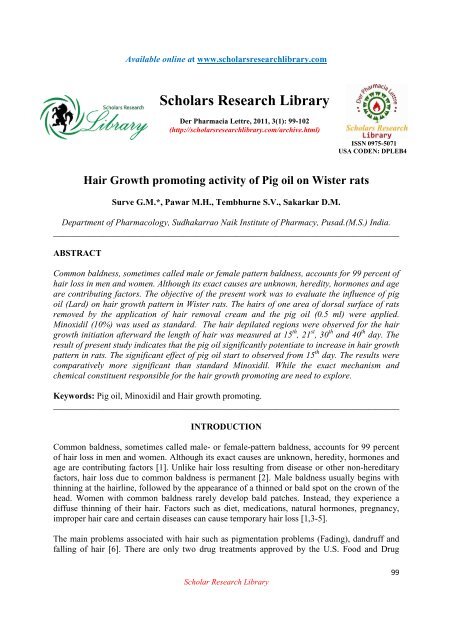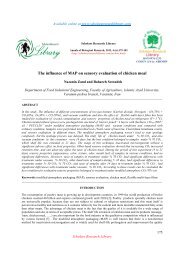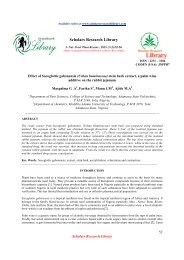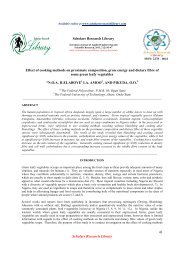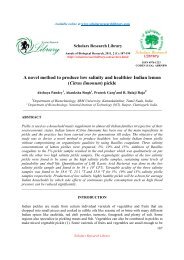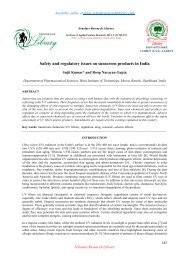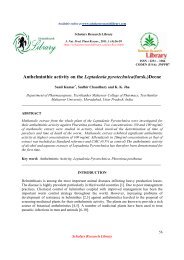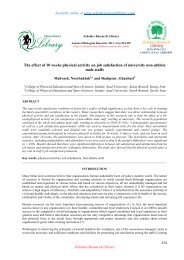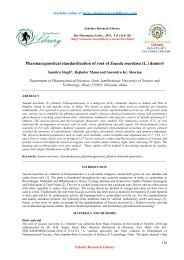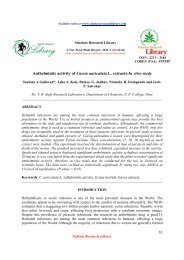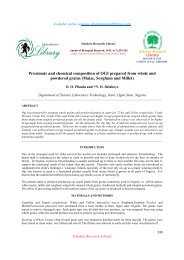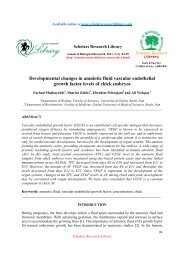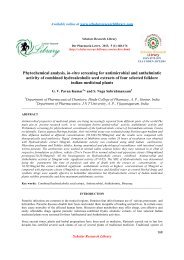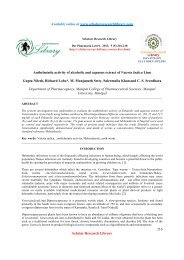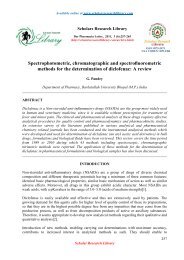Hair Growth Promoting Activity Of Pig Oil On - Scholars Research ...
Hair Growth Promoting Activity Of Pig Oil On - Scholars Research ...
Hair Growth Promoting Activity Of Pig Oil On - Scholars Research ...
You also want an ePaper? Increase the reach of your titles
YUMPU automatically turns print PDFs into web optimized ePapers that Google loves.
Available online at www.scholarsresearchlibrary.com<br />
<strong>Scholars</strong> <strong>Research</strong> Library<br />
Der Pharmacia Lettre, 2011, 3(1): 99-102<br />
(http://scholarsresearchlibrary.com/archive.html)<br />
<strong>Hair</strong> <strong>Growth</strong> promoting activity of <strong>Pig</strong> oil on Wister rats<br />
Surve G.M.*, Pawar M.H., Tembhurne S.V., Sakarkar D.M.<br />
Scholar <strong>Research</strong> Library<br />
ISSN 0975-5071<br />
USA CODEN: DPLEB4<br />
Department of Pharmacology, Sudhakarrao Naik Institute of Pharmacy, Pusad.(M.S.) India.<br />
______________________________________________________________________________<br />
ABSTRACT<br />
Common baldness, sometimes called male or female pattern baldness, accounts for 99 percent of<br />
hair loss in men and women. Although its exact causes are unknown, heredity, hormones and age<br />
are contributing factors. The objective of the present work was to evaluate the influence of pig<br />
oil (Lard) on hair growth pattern in Wister rats. The hairs of one area of dorsal surface of rats<br />
removed by the application of hair removal cream and the pig oil (0.5 ml) were applied.<br />
Minoxidil (10%) was used as standard. The hair depilated regions were observed for the hair<br />
growth initiation afterward the length of hair was measured at 15 th , 21 st , 30 th and 40 th day. The<br />
result of present study indicates that the pig oil significantly potentiate to increase in hair growth<br />
pattern in rats. The significant effect of pig oil start to observed from 15 th day. The results were<br />
comparatively more significant than standard Minoxidil. While the exact mechanism and<br />
chemical constituent responsible for the hair growth promoting are need to explore.<br />
Keywords: <strong>Pig</strong> oil, Minoxidil and <strong>Hair</strong> growth promoting.<br />
______________________________________________________________________________<br />
INTRODUCTION<br />
Common baldness, sometimes called male- or female-pattern baldness, accounts for 99 percent<br />
of hair loss in men and women. Although its exact causes are unknown, heredity, hormones and<br />
age are contributing factors [1]. Unlike hair loss resulting from disease or other non-hereditary<br />
factors, hair loss due to common baldness is permanent [2]. Male baldness usually begins with<br />
thinning at the hairline, followed by the appearance of a thinned or bald spot on the crown of the<br />
head. Women with common baldness rarely develop bald patches. Instead, they experience a<br />
diffuse thinning of their hair. Factors such as diet, medications, natural hormones, pregnancy,<br />
improper hair care and certain diseases can cause temporary hair loss [1,3-5].<br />
The main problems associated with hair such as pigmentation problems (Fading), dandruff and<br />
falling of hair [6]. There are only two drug treatments approved by the U.S. Food and Drug<br />
99
Surve G.M et al Der Pharmacia Lettre, 2011, 3(1): 99-102<br />
______________________________________________________________________________<br />
Administration (FDA) for male pattern baldness Minoxidil and Finasteride. Synthetic drug,<br />
minoxidil is a potent vasodilator appears safe for long term treatment. After 5 years use of 2 and<br />
3 % topical minoxidil, the improvement has been shown to peak in one year with a slow decline<br />
in regrowth over subsequent years [7]. Long term treatment with local side effects may be a<br />
problem with continuing use of minoxidil lotion [8, 9].<br />
There are also number of medicinal plant are reported to use for hair growth in badness such as<br />
caffeine, Lygodii spora, Polygara senega, Tridax procumbens etc [10-13]. There is no any<br />
scientific report available on pig oil for its applications for hair growth except lard production<br />
and in bakery [14]. It is also used in the development of experimental model for the obesity in<br />
High Fatty Diet model [15]. In hair parlor pig oil is used on the crown of head for quick<br />
appearance of hair. Thus the objective of the present study was to evaluate the effect of pig oil on<br />
hair growth pattern in Wister rats<br />
MATERIALS AND METHODS<br />
Collection and Administration of <strong>Pig</strong> oil: <strong>Pig</strong> oil was obtained from the local market and apply<br />
topically in the same form in dose of 0.5 ml.<br />
Animals<br />
Wistar albino rats weighing about 150-250 g of either sex acclimatized to the experimental room<br />
at temperature 28±2 °C, controlled humidity conditions (50-55%). They caged with a maximum<br />
of two animals in polypropylene cage and fed with standard food pellets (Amrut Food Sangali,<br />
Maharastra India) and water ad libitum. The study conducted after obtaining ethical committee<br />
clearance from the institutional animal ethical committee of SNIOP.<br />
Experimental<br />
The method described by Saraf, et al [10] used. Screening of hair growth potential was evaluated<br />
in Wistar albino rats weighing 150 –250 gm. The hairs of the dorsal portion of the rats (2-3cm)<br />
clipped with scissor and the hair removed after the application of hair removal cream (Anne<br />
French). For the topical application, only the hair of one area on the dorsal surface was removed.<br />
After removal of hair, animals divided into three groups, each group containing 5 animals. Group<br />
I was normal without any application. Group II apply 0.5 ml of <strong>Pig</strong> oil and group III apply<br />
topical application of 0.5 ml standard Minoxidil (10%). The hair depleted regions were observed<br />
for hair growth initiation afterward the length of hair was measured at 15 th , 21 st , 30 th and 40 th day<br />
and compare it with length of hair at side region for withdrawal of therapy.<br />
RESULTS AND DISCUSSION<br />
Baldness is a common problem found in both male and female. The factors responsible for the<br />
hair loss are various. There are very limited drug treatments are available for the baldness<br />
among these Minoxidil is a popular drug and is found to be safe also. While after few year use<br />
there is decline in the regrowth of hair [8]. There are also reported some side effects with the<br />
minoxidil. In hair parlor pig oil is used on the crown of head for quick appearance of hair. Thus<br />
the objective of the present study was to evaluate the effect of pig oil on hair growth pattern in<br />
Wister rats.<br />
Scholar <strong>Research</strong> Library<br />
100
Surve G.M et al Der Pharmacia Lettre, 2011, 3(1): 99-102<br />
______________________________________________________________________________<br />
Length of <strong>Hair</strong> (cm.)<br />
3<br />
2<br />
1<br />
0<br />
15 Day Control<br />
30 Day Control<br />
Fig 1: Effect of <strong>Pig</strong> oil on <strong>Hair</strong> regrowth in rats<br />
Fig.2: Effect of <strong>Pig</strong> oil on hair growth pattern on wister rats<br />
�<br />
�<br />
15 Day <strong>Pig</strong> <strong>Oil</strong><br />
30 Day <strong>Pig</strong> <strong>Oil</strong><br />
�<br />
��<br />
15 days 21 days 30 days 40 days<br />
Treatments period<br />
Vehicle control <strong>Pig</strong> <strong>Oil</strong> Minoxidil<br />
Scholar <strong>Research</strong> Library<br />
�<br />
15 Day Minoxidil<br />
30 Day Minoxidil<br />
� �<br />
Values are given in mean ± SD for groups of five rats in each. Values are statistically significant at p
Surve G.M et al Der Pharmacia Lettre, 2011, 3(1): 99-102<br />
______________________________________________________________________________<br />
The result of study shows that the complete hair growth was observed after 40 days in normal<br />
animals. The application of test sample (<strong>Pig</strong> oil) and standard Minoxidil do not produce any<br />
considerable effect on initiation of hair growth (approximately 7 days) compare to normal<br />
animals while the chronic application of drugs for more than 15 days indicates to decrease in the<br />
time interval for complete hair regrowth (Fig 1 and 2). The results of topical application of pig<br />
oil found to normalize the hair pattern after 30 days approximately (the application of pig oil stop<br />
thereafter) while for minoxidil it take more than 35 days for normal make up. Thus from the<br />
results it concludes that pig oil more potentiate to increased the hair regrowth pattern compared<br />
to minoxidil. While the exact mechanism in potentiation of hair regrowth by pig oil is unknown<br />
thus there is need to explore pig oil for its potentiation for its hair growth activity.<br />
REFERENCES<br />
[1] Rebora A (2004). J Am Acad Dermatol 50 (5): 777–9.<br />
[2] Chumlea W, Rhodes T, Girman C, Johnson-Levonas A, Lilly F, Wu R, Guo S (2004).<br />
Dermatology 209 (1): 33–9.<br />
[3] Stárka L, Cermáková I, Dusková M, Hill M, Dolezal M, Polácek V (2004). Exp Clin<br />
Endocrinol Diabetes 112 (1): 24–8<br />
[4] Schmidt J (1994). Skin Pharmacol 7 (1-2): 61–6.<br />
[5] Birch MP, Lalla SC, Messenger AG (July 2002). Clin. Exp. Dermatol. 27 (5): 383–88<br />
[6] Butler H. Poucher’s Perfumes, Cosmetics and Soaps. 9th ed. Chapman and Hall: London;<br />
1993. Vol.3.p.130.<br />
[7] Olsen EA, Weiner MS, Amara IA, Delory ER, Brit. J Am Acad Dermatol 1990; 22: 643-646.<br />
[8] Wilson C, Walkden V, Powell S, Shaw S, Wilkinson J, Dawber R. Brit. J Am Acad Dermatol<br />
1991; 24: 661-662.<br />
[9] Bhalerao SS, Solanki N H. Indian Drugs 2002; 39: 567.<br />
[10] Saraf S, Pathak AK, Dixit VK. Fitoterapia 1991; 62: 495-98.<br />
[11] Matsuda H, Yamazaki M, Naruo S, Asanuma Y, Kubo M. Biol Pharm Bull 2002; 25: 622-<br />
26.<br />
Scholar <strong>Research</strong> Library<br />
102


